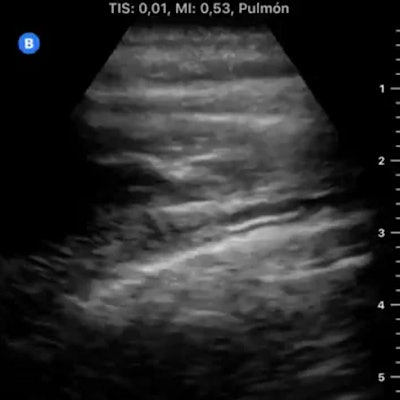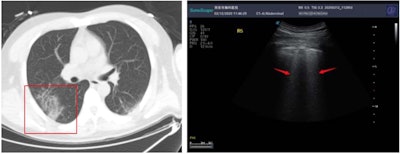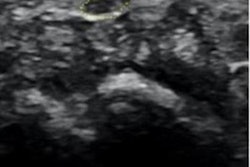
It's impossible to talk about ultrasound in 2020 without mentioning the COVID-19 pandemic. But perhaps unlike with other imaging modalities, the novel coronavirus pandemic has put a spotlight on larger, evolving trends in ultrasound research and use.
For instance, the outbreak has showcased the truly global role of ultrasound research, elevating the voices of teams from Asia, the Americas, and Europe. It has also cast full light on some of ultrasound's major benefits, including its ease of disinfection and recent advances that have made point-of-care ultrasound (POCUS) technology smaller, lighter, and more portable.
In terms of COVID-19, the radiology community has more often turned its attention to modalities with higher sensitivity, such as CT. This has given other, nontraditional ultrasound users the chance to shape the discussion around ultrasound use in 2020.
Global community rallies around ultrasound for COVID-19
The power of handheld ultrasound as an indispensable tool in the COVID-19 emergency was highlighted in March by an emergency doctor from Spain who chronicled his own journey with COVID-19 on Twitter. For two weeks, Dr. Yale Tung Chen shared daily POCUS scans showing the impact of the SARS-CoV-2 virus on his own body, changes that manifested in B-lines, a thickened pleural line, and later, subpleural consolidations.
"[Lesions] on my back started to clear up, then reappeared a couple of days later," Chen said in a March webinar. "It's something that is quite different from any other viral pneumonia that we have faced in the past."
By the fourth day following his diagnosis, Chen's ultrasound scan on his left side showed an increasingly thickened pleural line and two subpleural consolidations. Video courtesy of Dr. Yale Tung Chen.
Chen was publishing his Twitter diary just as the global ultrasound community was beginning to understand the benefit of all types of ultrasound systems for COVID-19 imaging. As Chen posted his own findings, experts from around the world were documenting similar features in their own patients.
In a March 12 letter in Intensive Care Medicine, researchers from Changsha, China, were among the first to describe how they used lung ultrasound to monitor more than a dozen patients with COVID-19 infections. The letter documented five characteristic findings of COVID-19 pneumonia on ultrasound scans that would later be known as hallmark signs of the new disease, including a thickened pleural line and a variety of B-line patterns.
In the letter, the team from China also touted the properties of ultrasound that made it beneficial compared to CT chest scans, which had already become the gold standard for lung imaging in patients with the novel coronavirus due to the modality's unparalleled sensitivity. The team pointed to ultrasound's benefits of easier infection control and use in patients who can't be moved, a refrain that would be echoed by research teams in other countries in the following months.
 Above: A CT scan and ultrasound scan from one patient with COVID-19. Below: A CT scan and ultrasound scan from a second patient with COVID-19. All images published in SSRN and courtesy of Yi Huang and colleagues.
Above: A CT scan and ultrasound scan from one patient with COVID-19. Below: A CT scan and ultrasound scan from a second patient with COVID-19. All images published in SSRN and courtesy of Yi Huang and colleagues.Not even two weeks after the China team published its findings, a group from Italy released similar results in patients with COVID-19 at Valle del Serchio General Hospital in Lucca. The group pushed the conversation forward by describing both findings and four ultrasound acquisition protocols.
The researchers' letter was one of the first times (but certainly not the last) that an Italian team issued COVID-19 ultrasound guidance. In fact, the letter's lead author, Dr. Gino Soldati, went on to publish his discovery of unusual findings on contrast-enhanced ultrasound (CEUS) scans of three patients with COVID-19 later admitted to the same hospital.
In a May letter, Soldati and colleagues described COVID-19 lung patterns not typically associated with pneumonia or lung collapse. Their report was early evidence that the mechanisms behind the novel coronavirus were not typical of viral pneumonia.
"Our and other observations suggest that there also may be an ulterior pattern of COVID-19 lung involvement in which the consolidations do not represent atelectasis or easily recruitable areas but tissue with large perfusion defects," Soldati and colleagues wrote.
Since May, researchers have continued to use ultrasound to document COVID-19 anomalies, including both cardiac and vascular complications. It's likely that global researchers will continue to capitalize on this momentum, sharing ultrasound findings that help the world medical community better understand how the virus works and why patients present with sometimes widely varying symptoms.
Using ultrasound findings to improve COVID-19 care
As the year has gone on, the conversation around ultrasound for COVID-19 has shifted from documenting findings to looking for ways to use those findings to improve patient care. Researchers haven't shied away from asking big questions, such as "Can ultrasound be used to predict COVID-19 outcomes?"
In July, physicians in Rome used POCUS to help answer that question. After scanning 41 patients with a pocket-sized device, they found patients with fatal cases of COVID-19 had pathological findings in 100% of scanned areas, compared with just 50% of scanned areas in discharged patients. Similarly, patients admitted to the intensive care unit (ICU) had pathological findings in 93% of scanned areas, as opposed to just 20% of areas in patients not admitted to the ICU.
Two weeks later, a team from China published results from a similar study. The group found pulmonary consolidation occurred significantly more often in patients with severe or critical COVID-19, and patients with a thickened pleural line experienced a longer infection period. Findings such as these could aid physicians in managing patients with moderate to severe COVID-19, the authors noted.
COVID-19 sheds light on ultrasound's versatility
From pocket-sized systems to repurposed ob/gyn equipment, more clinicians are using ultrasound systems and showcasing their incredible versatility for COVID-19 imaging in 2020.
In an Ultrasound in Obstetrics & Gynecology report, an Italian team demonstrated that the ultrasound probes and systems ob/gyn professionals typically rely on for prenatal checkups can also be used for lung imaging. The researchers pointed out that ob/gyn clinicians already have ultrasound experience and equipment in their practice. They also advised -- and described how to perform -- lung ultrasound scans on pregnant patients during prenatal appointments.
"Lung ultrasound can be considered as an 'extension' of the obstetric abdominal ultrasound evaluation," the authors wrote.
At the other end of the sonography size scale, physicians have repeatedly demonstrated the versatility of pocket-sized ultrasound systems for lung imaging. Perhaps the best feature of these smartphone-powered devices during the pandemic is the ease of infection control.
These benefits have been repeatedly lauded throughout the pandemic but were perhaps best summarized in an April commentary on the unique advantages of POCUS for COVID-19 imaging.
"It is feasible for the screen to be completely encased in a covering such as a Ziploc bag, and for transducers to be fully enclosed using sheaths," wrote the authors in an Academic Emergency Medicine article. "They may be particularly useful in situations where separate care or triage areas for cohorted COVID-19 patients are established outside the main areas where traditional machines reside."
Ultrasound's incredible versatility and ease of infection control have made it a popular modality in 2020 for COVID-19 imaging. However, this versatility is one of the reasons nonradiologists are using ultrasound more frequently than ever before.
While nontraditional specialties were already using ultrasound systems more frequently, it's possible that the pandemic is hastening this trend, according to emergency medicine physician Dr. Elias Jaffa.
"A lot of different groups are jumping on board very quickly, and so we're all going to have to deal with that rapid influx of people who are both training and also utilizing these imaging systems clinically," Jaffa said in a POCUS panel discussion at the 2020 Society for Imaging Informatics in Medicine meeting.
During the panel discussion, Jaffa hypothesized that the more POCUS is used or discussed for COVID-19, the more different specialties will learn about its benefits for multiple types of patient care. It's also impossible to ignore that many of the researchers behind ultrasound use for COVID-19 are emergency medicine physicians and intensivists.
"This is one of those situations where we actually may find multiple specialties in agreement that the risk of the patient going to formal radiology may be too high -- not only to the patients but also to the staff manning those areas and the other patients who come through those areas," Jaffa said.
Ultrasound for diagnostic imaging
Even before the pandemic became the top news story of the year, researchers were interested in the use of ultrasound for pneumonia imaging.
In a February study, researchers from Turkey compared lung ultrasound to chest CT scans in patients in the emergency department with suspected pneumonia. The team found ultrasound had comparable rates of sensitivity and specificity to CT, the gold standard for pneumonia diagnosis, and concluded that lung ultrasound may be a viable first-line imaging choice for patients in the emergency department.
That research was followed up by a March study demonstrating ultrasound's use for pneumonia imaging in children. In the study, researchers from Germany demonstrated that the combination of chest x-ray and lung ultrasound could be an alternative to high-radiation modalities, like CT.
This year researchers also demonstrated that clinicians can use ultrasound features to detect deep vein thrombosis (DVT). In a study in PLOS One, a team from the Netherlands showed that three different types of compression ultrasound regularly used to identify DVT all performed well.
More recently, a team from the U.S. found that ultrasound showed promise as a painless way to diagnose carpal tunnel syndrome. In a September study, the group showed that ultrasound features such as cross-sectional area, stiffness, and vascularity of the median nerve accurately differentiated between patients with and without carpal tunnel syndrome.
However, even more traditional diagnostic ultrasound use hasn't been spared by the pandemic. An April survey from market research firm IMV Medical Information Division, a sister company of AuntMinnie.com, found more than 90% of imaging centers in the U.S. experienced a major decline in the volume of procedures not related to COVID-19.
| Impact on procedure volume due to novel coronavirus in U.S. | |
| Imaging modality | Procedure volume |
| Mobile general x-ray units | -6.8% |
| Fixed PET and/or PET/CT | -24.5% |
| CT scanners | -37.5% |
| Fixed general x-ray radiography units | -38.6% |
| Fixed C-arm systems | -40.1% |
| Ultrasound units | -42.7% |
| Portable C-arm units | -44.6% |
| Fixed nuclear medicine cameras | -47% |
| Fixed MRI scanners | -47.4% |
| Fixed radiographic fluoroscopy systems | -48.1% |
| X-ray mammography units | -70.4% |
Even after factoring in COVID-19 imaging, respondents said volume dropped for all 11 surveyed modalities, including ultrasound. With a 43% drop in imaging volume, ultrasound fell in the middle of the pack, faring better than mammography units (-70%) but not nearly as well as mobile x-ray systems (-7%).
It's very possible that ultrasound departments and users may still be feeling the effects of this drastic drop of procedure volumes in the spring. As the industry braces for a likely second wave of COVID-19, it's important to remember that the changes in procedure volume directly affected staffing and budgets.
"The significant drop in multiple modalities that we have just seen directly impacts their operations, including staffing, operating hours, and their budgets," said Lorna Young, senior director of insights at IMV, during a webinar on the survey findings.



















